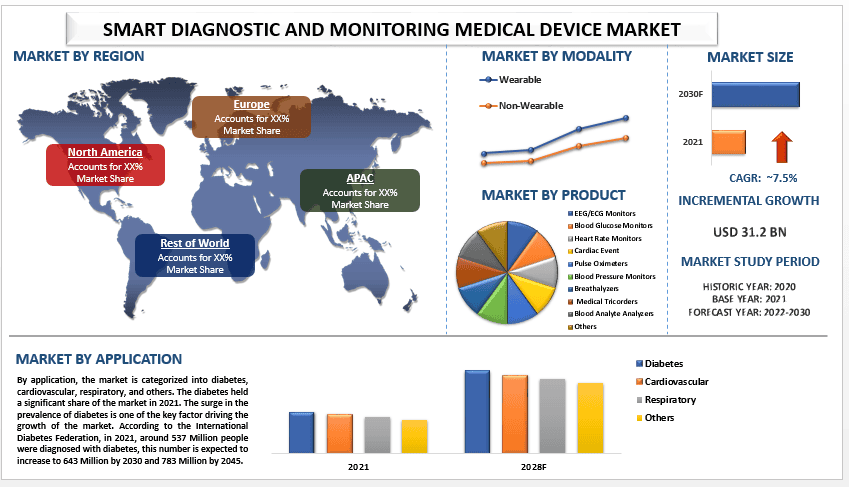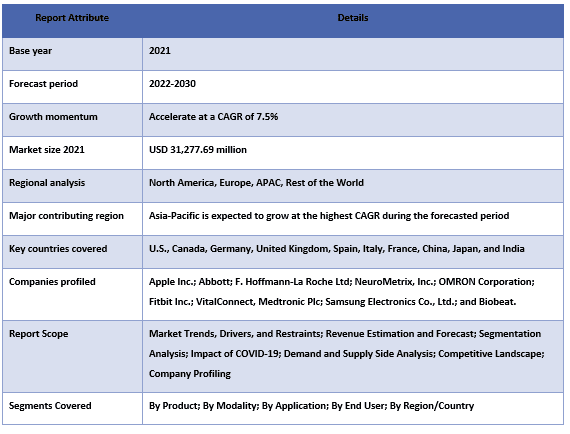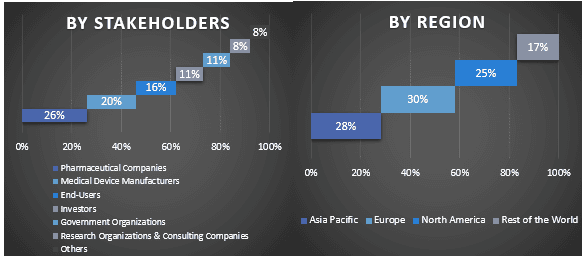- Home
- About Us
- Industry
- Services
- Reading
- Contact Us
Smart Diagnostic and Monitoring Medical Device Market: Current Analysis and Forecast (2022-2030)
Emphasis on Product (EEG/ECG Monitors, Blood Glucose Monitors, Heart Rate Monitors, Cardiac Event, Pulse Oximeters, Blood Pressure Monitors, Breathalyzers, Medical Tricorders, Blood Analyte Analyzers, and Others); Mobility (Wearable and Non-Wearable); Application (Diabetes, Cardiovascular, Respiratory, and Others); and End User (Hospitals, Clinics, and Homecare); Region/Country.

The smart diagnostic and monitoring medical device market is expected to grow at a strong CAGR of around 7.5% during the forecast period. The market is growing with increased awareness of health consciousness among individuals. Over the last couple of years, people all over the world have become more self-aware of the importance associated with living a healthy lifestyle. Because of this, fitness has become a trend for millions of people, leading to a rapid increase in the size and popularity of the global smart diagnostic and monitoring medical device industry. Even though most people now live more sedentary lives, an increasing number of individuals are opting for a more proactive lifestyle; the benefits are plenty and well-known. As per Neilsen, Aussie mindsets are focused on keeping healthy as the country faces another round of lockdowns. This behavior goes beyond avoiding COVID. In fact, for 80% of Australians, keeping themselves and their families healthy is a top priority, an 11-percentage point lift from five years prior. Moreover, 52% of US smartphone and smartwatch owners use their devices to collect health-related information or exercise regularly after having more accessibility to this kind of software.
Some of the major players operating in the Apple Inc.; Abbott; F. Hoffmann-La Roche Ltd; NeuroMetrix, Inc.; OMRON Corporation; Fitbit Inc.; VitalConnect, Medtronic Plc; Samsung Electronics Co., Ltd.; and Biobeat. Several M&As along with partnerships have been undertaken by these players to facilitate customers with hi-tech and innovative products/technologies.
Insights Presented in the Report
“Amongst product, the blood glucose monitors segment to grow with high CAGR during the forecast period”
Based on the product, the market is segmented into EEG/ECG monitors, blood glucose monitors, heart rate monitors, cardiac event, pulse oximeters, blood pressure monitors, breathalyzers, medical tricorders, blood analyte analyzers, and others. The blood glucose monitors is anticipated to witness high CAGR during the forecast period. Smart blood glucose monitors have shown tremendous growth owing to the surge in the prevalence of diabetes and the growing adoption of digital health solutions. The market for smart blood glucose monitors is highly competitive, with several prominent players in the industry. Some of the key players include Abbott, Roche, Dexcom, Medtronic, and ForaCare, among others. For example, OneDrop is a digital health company that offers OneDrop glucose monitoring systems.
“Amongst modality, the wearable category held a significant share of the market in 2021”
By modality, the market is bifurcated into wearable and non-wearable. The wearable devices held a dominant share of the market in 2021. The use of wearable devices in a bid to combat COVID-19 has therefore been ramped up. Research has recently expanded on whether the extensive data that wearable devices collect can predict the onset of the virus or not. For instance, according to a study published in NCBI in July 2022, 22 distinct types of wearable technology devices, such as smartwatches or fitness trackers, medical devices, and others, are utilized to identify COVID-19 infections. Such a huge adoption of wearable medical devices during the pandemic has been expected to drive market growth.
Smart Diagnostic and Monitoring Medical Device Market Report Coverage

“Amongst application, the diabetes category held a significant share of the market in 2021”
By application, the market is categorized into diabetes, cardiovascular, respiratory, and others. The diabetes held a significant share of the market in 2021. The surge in the prevalence of diabetes is one of the key factor driving the growth of the market. According to the International Diabetes Federation, in 2021, around 537 Million people were diagnosed with diabetes, this number is expected to increase to 643 Million by 2030 and 783 Million by 2045. The outbreak of COVID-19 has opened new opportunities for smart blood glucose monitoring devices and these devices gained more popularity in the diabetic care market.
“Asia Pacific to grow with high CAGR during the forecast period”
The Asia Pacific is anticipated to grow rapidly in the upcoming years owing to the rising awareness regarding the benefits of a healthy lifestyle among consumers. This can be because of the growing prevalence of diabetes and obesity in the region. For instance, according to the International Diabetes Federation, in 2021, 90 million adults aged 20-79 are living with diabetes in the IDF South-East Asia region. Further, this number is also anticipated to increase to 113 million by 2030 and 152 million by 2045.
Reasons to buy this report:
- The study includes market sizing and forecasting analysis validated by authenticated key industry experts.
- The report presents a quick review of overall industry performance at one glance.
- The report covers an in-depth analysis of prominent industry peers with a primary focus on key business financials, product portfolios, expansion strategies, and recent developments.
- Detailed examination of drivers, restraints, key trends, and opportunities prevailing in the industry.
- The study comprehensively covers the market across different segments.
- Deep dive regional level analysis of the industry.
Customization Options:
The global smart diagnostic and monitoring medical device market can further be customized as per the requirement or any other market segment. Besides this, UMI understands that you may have your own business needs, hence feel free to connect with us to get a report that completely suits your requirements.
Table of Content
Research Methodology for the Smart Diagnostic and Monitoring Medical Device Market Analysis (2022-2030)
Analyzing the historical market, estimating the current market, and forecasting the future market of the global smart diagnostic and monitoring medical device market were the three major steps undertaken to create and analyze the adoption of smart diagnostic and monitoring medical device in major regions globally. Exhaustive secondary research was conducted to collect the historical market numbers and estimate the current market size. Secondly, to validate these insights, numerous findings and assumptions were taken into consideration. Moreover, exhaustive primary interviews were also conducted, with industry experts across the value chain of the global smart diagnostic and monitoring medical device market. Post assumption and validation of market numbers through primary interviews, we employed a top-down/bottom-up approach to forecasting the complete market size. Thereafter, market breakdown and data triangulation methods were adopted to estimate and analyze the market size of segments and sub-segments of the industry pertains to. Detailed methodology is explained below:
Analysis of Historical Market Size
Step 1: In-Depth Study of Secondary Sources:
Detail secondary study was conducted to obtain the historical market size of the smart diagnostic and monitoring medical device market through company internal sources such as annual reports & financial statements, performance presentations, press releases, etc., and external sources including journals, news & articles, government publications, competitor publications, sector reports, third-party database, and other credible publications.
Step 2: Market Segmentation:
After obtaining the historical market size of the smart diagnostic and monitoring medical device market, we conducted a detailed secondary analysis to gather historical market insights and share for different segments & sub-segments for major regions. Major segments are included in the report as product, modality, application, and end user. Further country-level analyses were conducted to evaluate the overall adoption of testing models in that region.
Step 3: Factor Analysis:
After acquiring the historical market size of different segments and sub-segments, we conducted a detailed factor analysis to estimate the current market size of the smart diagnostic and monitoring medical device market. Further, we conducted factor analysis using dependent and independent variables such as product, modality, application, and end user of the smart diagnostic and monitoring medical device market. A thorough analysis was conducted for demand and supply-side scenarios considering top partnerships, mergers and acquisitions, business expansion, and product launches in the smart diagnostic and monitoring medical device market sector across the globe.
Current Market Size Estimate & Forecast
Current Market Sizing: Based on actionable insights from the above 3 steps, we arrived at the current market size, key players in the global smart diagnostic and monitoring medical device market, and market shares of the segments. All the required percentage shares split, and market breakdowns were determined using the above-mentioned secondary approach and were verified through primary interviews.
Estimation & Forecasting: For market estimation and forecast, weights were assigned to different factors including drivers & trends, restraints, and opportunities available for the stakeholders. After analyzing these factors, relevant forecasting techniques i.e., the top-down/bottom-up approach were applied to arrive at the market forecast for 2030 for different segments and sub-segments across the major markets globally. The research methodology adopted to estimate the market size encompasses:
- The industry’s market size, in terms of revenue (USD) and the adoption rate of the smart diagnostic and monitoring medical device market across the major markets domestically
- All percentage shares, splits, and breakdowns of market segments and sub-segments
- Key players in the global smart diagnostic and monitoring medical device market in terms of products offered. Also, the growth strategies adopted by these players to compete in the fast-growing market
Market Size and Share Validation
Primary Research: In-depth interviews were conducted with the Key Opinion Leaders (KOLs) including Top Level Executives (CXO/VPs, Sales Head, Marketing Head, Operational Head, Regional Head, Country Head, etc.) across major regions. Primary research findings were then summarized, and statistical analysis was performed to prove the stated hypothesis. Inputs from primary research were consolidated with secondary findings, hence turning information into actionable insights.
Split of Primary Participants in Different Regions

Market Engineering
The data triangulation technique was employed to complete the overall market estimation and to arrive at precise statistical numbers for each segment and sub-segment of the global smart diagnostic and monitoring medical device market. data was split into several segments & sub-segments post studying various parameters and trends in the areas of the product, modality, application, and end user in the global smart diagnostic and monitoring medical device market.
The main objective of the Global Smart Diagnostic and Monitoring Medical Device Market Study
The current & future market trends of the global smart diagnostic and monitoring medical device market were pinpointed in the study. Investors can gain strategic insights to base their discretion for investments on the qualitative and quantitative analysis performed in the study. Current and future market trends determined the overall attractiveness of the market at a regional level, providing a platform for the industrial participant to exploit the untapped market to benefit from a first-mover advantage. Other quantitative goals of the studies include:
- Analyze the current and forecast market size of the smart diagnostic and monitoring medical device market in terms of value (USD). Also, analyze the current and forecast market size of different segments and sub-segments
- Segments in the study include areas of the product, modality, application, and end user
- Define and analysis of the regulatory framework for the smart diagnostic and monitoring medical device industry
- Analyze the value chain involved with the presence of various intermediaries, along with analyzing customer and competitor behaviors of the industry
- Analyze the current and forecast market size of the smart diagnostic and monitoring medical device market for the major region
- Major countries of regions studied in the report include Asia Pacific, Europe, North America, and the Rest of the World
- Company profiles of the smart diagnostic and monitoring medical device market and the growth strategies adopted by the market players to sustain in the fast-growing market
- Deep dive regional level analysis of the industry
Related Reports
Customers who bought this item also bought










